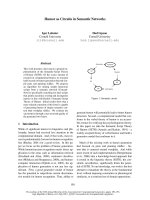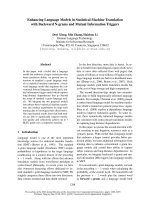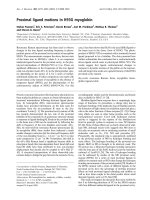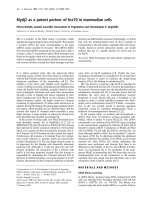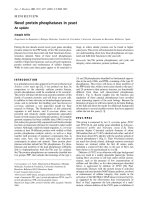Báo cáo y học: "Yeasts as models in evolutionary biology" ppt
Bạn đang xem bản rút gọn của tài liệu. Xem và tải ngay bản đầy đủ của tài liệu tại đây (56.98 KB, 3 trang )
Genome
BBiioollooggyy
2009,
1100::
304
Meeting report
YYeeaassttss aass mmooddeellss iinn eevvoolluuttiioonnaarryy bbiioollooggyy
Zhenglong Gu* and Stephen Oliver
†
Addresses: *Division of Nutritional Sciences, Cornell University, Ithaca, NY 14853, USA.
†
Department of Biochemistry, University of
Cambridge, Sanger Building, Tennis Court Road, Cambridge CB2 1GA, UK.
Correspondence: Zhenglong Gu. Email: ; Stephen Oliver. Email:
Published: 2 March 2009
Genome
BBiioollooggyy
2009,
1100::
304 (doi:10.1186/gb-2009-10-3-304)
The electronic version of this article is the complete one and can be
found online at />© 2009 BioMed Central Ltd
A report of the workshop ‘Evolutionary and Environmental
Genomics of Yeasts’, Heidelberg, Germany, 1-5 October 2008.
Around 100 scientists gathered at Heidelberg recently for a
workshop exploring the burgeoning use of yeasts in studies
of evolution and ecology. Yeasts as model systems permit an
ideal marriage between theory and experiment, and the
meeting concentrated on four core issues in evolutionary
biology: the architecture of the genome and its evolution; the
ecological and genetic structure of natural populations; the
mechanisms of selection that lead to adaptation, and their
study in the laboratory; and the evolution of sex and mating
systems. Here, we report a few of the highlights.
GGeennoommee ssttrruuccttuurree aanndd eevvoolluuttiioonnaarryy pprroocceessss
The genome sequences of many yeast species and strains are
now available, providing a playground for evolutionary
biologists to pursue comparative genomics. Bernard Dujon
(Institut Pasteur, Paris, France) presented the work of the
Génolevures consortium on the genome evolution of
hemiascomycetous yeasts, focusing on the evolution of novel
genes. The common ancestor of the Saccharomyces ‘sensu
stricto’ species complex (Saccharomyces species that can
mate to produce viable hybrids) underwent a whole-genome
duplication (WGD) around 100 million years ago, and as
Dujon described, this event had a profound effect on the
genome structure of the affected species and led to the
emergence of many genes with novel functions. In this
regard, Jed Dean (Stanford University, USA) discussed their
work showing that members of paralogous pairs of genes
created by WGD still exhibit a significant amount of
functional redundancy, which is thus a potential source of
further genetic innovation.
Aerobic fermentation emerged in different yeast species at
the end of the Cretaceous period when fruit sugars became
increasingly available. Yitzhak Pilpel (Weizmann Institute,
Rehovot, Israel) has found that genes needed for oxidative
respiration or fermentation have distinct translational
efficiencies in obligate aerobic or facultative species,
respectively. He used a measure of translation efficiency to
show that genes and functional modules have correlated
patterns of translational efficiency across species, and
sometimes even emerged independently in markedly differ-
ent evolutionary lineages (for example, S. cerevisiae and
Schizosaccharomyces pombe).
PPooppuullaattiioonn ssttrruuccttuurree aanndd ggeenneettiicc mmaappppiinngg
One important issue for population genetics is to infer
population history and population structure from current
patterns of genetic variation. ‘Population genomics’ has now
emerged as a new field as complete genome sequences of an
increasing number of yeast strains become available. The
population dynamics of members of the Saccharomyces
‘sensu’ stricto’ group were addressed by Vassiliki Koufo-
panou (Imperial College, London, UK), who presented the
results of sequencing chromosomes III from 20 isolates of
S. paradoxus. Chromosome III determines the sex of yeast
cells and her analysis indicated that S. paradoxus living on
oak trees may go through a sexual cycle approximately once
in every 1,000 asexual generations. This is our first intima-
tion of how frequently yeast perform the sexual act in at least
one of their natural environments.
Ed Louis (University of Nottingham, UK) presented the
results of sequencing the genomes of around 70 natural
isolates of S. cerevisiae and S. paradoxus from various geo-
graphical locations and ecological environments. Population
genetics analysis indicated that the S. paradoxus strains
divided into three distinct populations plus a single
Hawaiian isolate that differed from all the rest. In contrast,
most of the polymorphisms in the S. cerevisiae samples were
shared, indicating extensive recombination between lineages
in this species. Various evolutionary forces, such as purifying
selection and adaptive evolution, were detected in both
coding and regulatory sequences by analyzing the spectrum
of allele frequency distributions. Louis also mentioned that
phenotypic analyses for some 200 growth traits were being
carried out for all sequenced isolates in the hope of identi-
fying associations between genotype and phenotype.
A better understanding of yeast population structure should
lead to improved methods for association mapping. The high
meiotic recombination rates in yeast also make it a good
system for rapid mapping of the genetic determinants of
phenotypic differences between strains. Lars Steinmetz
(European Molecular Biology Laboratory (EMBL), Heidel-
berg, Germany) reported on the mapping of genes that
contribute to the high-temperature-growth (Htg) phenotype
of several pathogenic S. cerevisiae strains. Surprisingly,
besides identifying a major locus in the pathogenic Htg-
positive parent, he and colleagues also identified a gene in
the non-pathogenic parent that made a significant
contribution to the Htg phenotype of the hybrid. All involved
in quantitative trait locus mapping, whether in yeasts, plants
or humans, would do well to pay attention to such pheno-
mena. Steinmetz also presented the results of a study in
which whole-genome tiling arrays were used to genotype
approximately 200 tetrads from a cross between two S.
cerevisiae strains. This dense genetic map will open the door
to new studies of the impact of meiotic recombination on
yeast evolution and the panel of tetrads analyzed will
provide a superb platform for identifying genetic loci under-
lying yeast pathogenesis and related phenotypes.
EEvvoolluuttiioonnaarryy mmeecchhaanniissmmss
Mutation is the ultimate source of evolution; it is thus
necessary to determine how often mutations occur in nature.
Using forward mutations to canavanine resistance at the
CAN1 locus, Akira Shinohara (University of Osaka, Japan)
showed that mutation frequencies in meiosis are five- to ten-
fold higher than in mitosis. Andrew Murray (Harvard
University, Cambridge, USA) discussed genome-wide variation
in mutation rates. By placing URA3 as a marker gene at
multiple sites along S. cerevisiae chromosome VI, he and his
colleagues found that the variation in the frequency of
mitotic mutation rate at these different sites correlated with
the timing of their DNA replication.
Other than the mutation rate, what else determines the rate of
evolution? Claus Wilke (University of Texas, Austin, USA)
showed that mistakes in mRNA translation that result in
protein misfolding are major forces shaping the evolution of
coding sequences. Highly expressed genes, in particular,
evolve their coding sequences so as to maximize translational
fidelity. This explanation of the covariance of coding
sequences, codon usage, and mRNA levels is likely to hold
true for all branches of life. The importance of protein fold-
ing was also emphasized by Daniel Jarosz (Whitehead Insti-
tute for Biomedical Research, Cambridge, USA), who
showed that the chaperone protein Hsp90 influences the
expression of new phenotypes during evolution. Repeated
selection can allow the new phenotypes to become Hsp90-
independent, indicating that Hsp90 is important for the
assimilation of these new phenotypes into the organism’s
repertoire, but not necessarily for their continued stable
expression.
Genes do not evolve in isolation. Rather, their course of
evolution is the product of their interaction with other genes
and with the environment. Ryszard Korona (Jagiellonian
University, Krakow, Poland) has compared the growth of
both single and double deletants of S. cerevisiae in benign
and stress conditions. The comparison suggested an average
alleviating effect of interactions between stressful environ-
ments and gene deletions, and among the gene deletions
themselves. Paul Magwene (Duke University, Durham, USA)
discussed an interesting case of systematic pleiotropy
between sporulation and pseudohyphal growth in yeast. A
survey of the two phenotypes in different wild and labora-
tory yeast isolates indicates that a phenotypic trade-off led to
significant antagonistic pleiotropy during evolution.
Yeast is ideal for laboratory evolution experiments because
of its short generation time and the separate haploid and
diploid phases of its life cycle. Maitreya Dunham (University
of Washington, Seattle, USA) has identified mutations
underlying the organism’s adaptation to various nutrient-
limiting conditions. Only a small number of mutations were
associated with each condition, indicating that adaptation
can occur in very few steps - at least, in laboratory conditions
under strong selection. Rong Li (Stowers Institute, Kansas
City, USA) discussed an interesting case of laboratory
adaptation of myo1 deletants that overcame the severe
growth defects that are the consequence of the loss of this
gene. The results indicated that polyploidization and aneu-
ploidy are strongly correlated with favorable evolutionary
outcomes, an observation echoed by Dunham’s study. A
theoretical population genetics model presented by Sarah
Otto (University of British Columbia, Vancouver, Canada)
drew attention to the importance of polyploidy in masking
the effects of deleterious mutations, while demonstrating
that most populations converged on the diploid state over
time, with tetraploids being particularly disfavored.
EEvvoolluuttiioonn ooff mmaattiinngg aanndd ssppeecciiaattiioonn
The theory of sexual selection predicts that if an allele
confers an advantage in the competition for mates, it will
spread through a population. Duncan Greig (University
College London, UK) has found that, under high sexual
/>Genome
BBiioollooggyy
2009, Volume 10, Issue 3, Article 304 Gu and Oliver 304.2
Genome
BBiioollooggyy
2009,
1100::
304
selection, yeast strains that produce increased levels of the
α mating pheromone are preferred during mating and
invaded a population of weak signalers - a phenomenon
directly predicted by the sexual selection theory. The
downside to heightened pheromone production is that it
may impose a selective cost during vegetative growth. The
separation of sexual and asexual growth in the yeast life
cycle permitted a direct test of this idea by Greg Lang
(Princeton University, USA), who reported a trade-off
between growth and mating efficiency in yeast, indicating
that loss of genes involved in mating-pheromone production
could be adaptive for the organism during vegetative growth,
an event that is frequently observed in yeast during
experimental evolution.
In regard to speciation, Jun-Yi Leu (Academia Sinica, Taiwan)
discussed the nuclear-mitochondrial genome incompatibility
that leads to hybrid sterility in crosses between S. bayanus
and S. cerevisiae, and showed that the nuclear-encoded
mitochondrial AEP2 gene on chromosome XIII of
S. bayanus was incompatible with S. cerevisiae mitochondria.
In a similar system, Oliver Zill (University of California,
Berkeley, USA) showed that the S. cerevisiae SIR4 gene
cannot silence the S. bayanus HM loci, another possible
reason for the incompatibility between the two species.
Interestingly, Zill showed that SIR4 might be under strong
positive selection in the Saccharomyces ‘sensu stricto’ clade.
Geraldine Butler (University College Dublin, Ireland) dis-
cussed results from sequencing a group of Candida species
that translate CTG as serine instead of leucine. Members of
this clade differ greatly in their ability to undergo sexual
reproduction - some have perfect sexual cycles, others show
cryptic sexuality, and others are completely sterile. Butler
has found that these differences relate to the loss of genes
involved in the pathway leading to meiosis, with even the
fully sexual species showing a mechanism of meiosis more
similar to that of Drosophila than to that of Saccharomyces.
Whether such gene loss was the cause of reproductive
isolation that produced the different species, or whether it
occurred subsequent to speciation, is yet to be resolved.
The mechanism of post-zygotic isolation in speciation was
also studied at the protein level by Daniela Delneri
(University of Manchester, UK), who investigated the ability
of hybrids between different Saccharomyces ‘sensu stricto’
species to assemble protein complexes containing compo-
nents from both parents. Examples of chimerism were found
for all three protein complexes studied, but the ability to
form chimeras did not correlate with the degree of sequence
divergence between species.
NNeeww ffrroonnttiieerrss iinn eevvoolluuttiioonnaarryy bbiioollooggyy
On the systems biology front, one of us (SO) discussed the
results of competition experiments between heterozygous
yeast deletants grown in both nutrient-limiting (chemostat)
and nutrient-sufficient (turbidostat) cultures. Both haplo-
insufficient (heterozygotes that grow more slowly than the
wild type) and haploproficient (heterozygotes that grow
faster than wild type) were found in all selective environ-
ments. Haploproficiency was revealed less often in turbido-
stat culture than in chemostats, but its very existence under
nutrient-unconstrained conditions suggests that, over
evolutionary time, yeast has sacrificed increased growth rate
to improved fidelity of reproduction.
Chiraj Dalal (Caltech, Pasadena, USA) reported a novel
mode of regulating gene transcription. The Crz1 zinc-finger
transcription factor was shown to exhibit bursts of nuclear
localization upon exposure of the cells to calcium. Interest-
ingly, different calcium concentrations controlled the
frequency, but not the duration, of these bursts. In this way,
frequency-modulated control can coordinate expression
from multiple promoters having different threshold
functions. Chris Landry (University of Montreal, Montreal,
Canada) presented a novel method, the protein fragment
complementation assay (PCA), to carry out genome-wide
screens for protein-protein interactions. The method identi-
fied many novel in vivo interactions, revealing a previously
unknown domain of the yeast protein interactome and
winning the best poster award for Landry.
This meeting demonstrated that our deep understanding of
yeasts and the advanced tools available for their genetic
manipulation could mean that these organisms will become
as important for research in evolutionary biology as they
have been in cellular and molecular biology. Evolutionary
biologists will have to be prepared to exploit the potential
ability to sequence a yeast genome for a few hundred dollars,
while yeast researchers will have to adopt an increasingly
evolutionary perspective in their understanding of these
organisms. As Theodosius Dobzhansky put it: “Nothing in
biology makes sense except in the light of evolution”. Yeasts
are no exception.
/>Genome
BBiioollooggyy
2009, Volume 10, Issue 3, Article 304 Gu and Oliver 304.3
Genome
BBiioollooggyy
2009,
1100::
304

